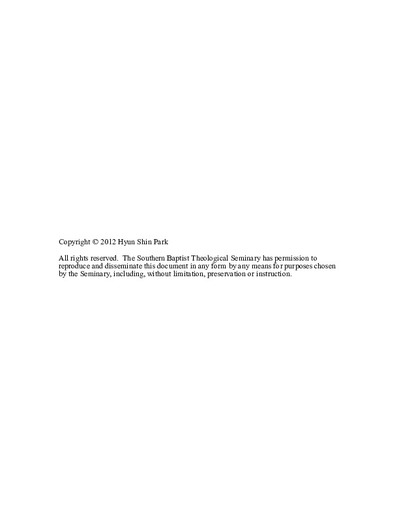Toward A Life-Changing Application Paradigm in Expository Preaching
Abstract
The primary aim of this dissertation is to examine the hermeneutical foundation, the biblical basis, the historical principle, and then to formulate a four-bridge application paradigm based on four distinguished processes--exegetical, doctrinal, homiletical, and transformational--aiming at transforming the lives of listeners for the glory of God.
Chapter 1 analyzes the indispensability of a well-balanced hermeneutical application paradigm by arguing the relationship between hermeneutics and application, by reexamining application paradigms and bridge-building models, and by refocusing the four bridge paradigm.
Chapter 2 examines the sermons of biblical prototypes--Moses, Ezra, the Minor Prophets, and Paul--and their features of application paradigms by means of a paradigmatic analyses rather than an exhaustive one. This chapter thoroughly explores Paul's sermons in his epistles, his preaching in Acts, and his hermeneutical bridge-building paradigm. The essential characteristics of these biblical models lead to a four-bridge life-changing application paradigm.
Chapter 3 investigates four exemplary historical models--John Chrysostom, John Calvin, Jonathan Edwards, and John Broadus--and examines their illustrative sermons to identify their indispensable principles of application paradigms and to apply these historical facets for formulating a contemporized application paradigm. Four models provide a historical validation to formulate a legitimate life-changing application paradigm.
Chapter 4 proposes a four-bridge application paradigm rooted in hermeneutical, biblical prototypes and historical models. The chapter systemizes (1) an exegetical bridge for discerning the aim of author-intended signification and the criteria for transferring universal principles of application (2) a doctrinal bridge for examining seven master keys to unlock the universal principles of ethical application, (3) a homiletical bridge for identifying a variety of relevance categories, legitimate methodologies of audience exegesis and adaptation, and an appropriate degree of transfer, and (4) a Spirit-led transformational bridge that is legitimate to change the lives of listeners.
Chapter 5 concludes that contemporary preachers, as bridge-builders, need to seek a life-transforming application paradigm by utilizing the exegetical bridge, the doctrinal bridge, the homiletical bridge and the Spirit-led transformational bridge.

